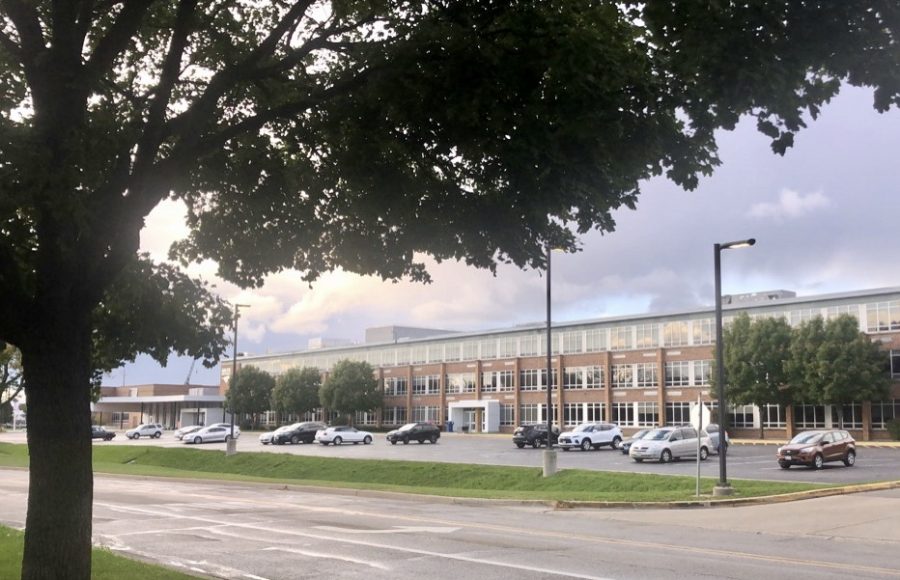Overcoming and adapting: Teachers go remote learning
Many teachers have decided to come back to DGS and teach classes from there to feel more like they are in a classroom.
Over the summer, District 99 and their teaching staff created and developed a teaching plan for students in a remote setting. Since the fallout of the first hybrid plan, teachers in all departments seem to struggle in different ways when navigating different ways of teaching while still abiding by COVID-19 regulations.
One of the main ways teachers have had to adapt to being remote is becoming more in-tune with technological tools such as Zoom and Google Classroom. Math teacher Negin Voss discusses how she has had to change the way she uses technology to help better teach her students.
“These past few months, I have definitely become more tech savvy. Last spring, I learned about Zoom and Google Meets; I recorded video lessons for the first time and posted them into Google Classroom, which was new for me as well. Now, I am teaching live, synchronously and using a note-taking app called Kami. I am also creating homework assignments and assessments online,” Voss said.
English teacher Nathaniel Haywood also speaks on how he has altered his teaching methods to account for teaching remotely:
“My general approach to teaching is to use a lot of peer & group work to encourage discussion, critical thought, independence and build relationships. That is much more challenging in a remote setting, particularly with the frequent internet issues that occur within a Zoom meeting,” Haywood said.
Internet issues and having to quickly learn how to navigate technology brings various issues not only to teachers, but students as well. Senior Austin Davis speaks on the ways in which she has struggled with her classes being online:
“On Zoom, my WiFi cuts out often, leaving me unable to hear my teacher or my peers. It’s so frustrating missing important sections of the lesson, and I am sometimes nervous to ask my teacher to repeat themselves… It’s so uncomfortable talking in front of the entire Zoom meeting,” Davis said.
Davis’ concerns have gone unnoticed as other teachers like Voss also struggle with the lack of engagement remote learning brings including awkward and uncomfortable tension.
“I have a few students who are silent and will not respond unless I ask a fun, exit slip question — that has been tough and has hindered the process in building a solid relationship with some students. I am trying to be creative and keep my students engaged; however, sometimes when that black screen is staring at me, I just cannot be too sure. I am staying positive and trying to make the best out of the situation,” Voss said.
Haywood also acknowledges the difficulties in forming good teacher-student relationships.
“The most challenging part of being remote is building connections with students. Interaction through a computer screen with small images of student faces and often with no images at all due to connection issues makes it difficult to forge relationships,” Haywood said.
Haywood continues: “Building relationships has been a real challenge this year. This is particularly true with underclassmen who have not strongly established themselves in high school yet and are not as comfortable breaking out of their shells on-screen,” Haywood said.
Freshman Lauren Miranda, like other freshmen this year, has had to start her first year at DGS on-screen. She feels similar to Haywood in the sense that it’s very hard to get a true high school experience being remote.
“The most weird part about being in online school is trying to get to know your teachers and classmates. Communication is very limited over a screen, so it’s hard to get acquainted with everyone and feel like you’re actually in high school … Although the staff at DGS is doing a good job, nothing can replace the teaching connections made in an in-person learning environment,” Miranda said.
Although every department has been hit hard by the new regulations, one of the departments that has been hit the hardest is the P.E. department. Finding new ways to have students exercise and engage in a gym class is more difficult on a computer screen than in person. Jillian Erzig, one of the P.E. teachers, explains some of the difficulties of holding a gym class while being remote:
“To some extent I have felt like a brand new teacher, especially at first [of remote learning]. With my health and P.E. classes, I have created a culture of using Zoom as a platform to have quality class discussions — and that did not happen overnight,” Erzig said.
A new hybrid plan implemented by the board is allowing students and staff to come back to school the first week of October. Erzig describes her excitement to see her students face-to-face.
“I love my job and being at work with my students and colleagues. I miss that face-to-face contact so much. I am excited to be back to work to meet my freshmen and be back and connected with my department,” Erzig said.
The obstacles that teachers and students have had to deal with since going remote have been difficult to get through. Internet issues, lack of relationships and major changes still leave many people in the community shaken. However, teachers such as Voss try to stay as supportive and positive as possible while in such unprecedented times:
“Honestly, I think I have been lucky. I have wonderful students in all of my classes and students participating and volunteering answers daily. Overall, I believe I have still been able to make my students feel comfortable ‘in-class’ via Zoom and have reassured them that I am here to support them in any way,” Voss said.


